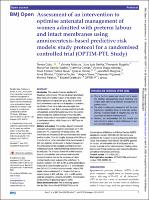| dc.contributor | Vall d'Hebron Barcelona Hospital Campus |
| dc.contributor.author | Aldecoa, Victoria |
| dc.contributor.author | Bartha, Jose Luis |
| dc.contributor.author | Carrillo-Badillo, María Paz |
| dc.contributor.author | Goya Canino, Maria del Mar |
| dc.contributor.author | Cobo, Teresa |
| dc.contributor.author | Bugatto, Fernando |
| dc.contributor.author | Comas, Carmina |
| dc.date.accessioned | 2022-05-02T13:17:54Z |
| dc.date.available | 2022-05-02T13:17:54Z |
| dc.date.issued | 2021-09-28 |
| dc.identifier.citation | Cobo T, Aldecoa V, Bartha JL, Bugatto F, Carrillo-Badillo MP, Comas C, et al. Assessment of an intervention to optimise antenatal management of women admitted with preterm labour and intact membranes using amniocentesis-based predictive risk models: study protocol for a randomised controlled trial (OPTIM-PTL Study). BMJ Open. 2021 Sep 28;11(9):e054711. |
| dc.identifier.issn | 2044-6055 |
| dc.identifier.uri | https://hdl.handle.net/11351/7456 |
| dc.description | Fetal medicine; Maternal medicine; Ultrasonography |
| dc.description.abstract | Introduction The majority of women admitted with threatened preterm labour (PTL) do not delivery prematurely. While those with microbial invasion of the amniotic cavity (MIAC) represent the highest risk group, this is a condition that is not routinely ruled out since it requires amniocentesis. Identification of low-risk or high-risk cases might allow individualisation of care, that is, reducing overtreatment with corticosteroids and shorten hospital stay in low-risk women, while allowing early antibiotic therapy in those with MIAC. Benefits versus risks of amniocentesis-based predictor models of spontaneous delivery within 7 days and/or MIAC have not been evaluated.
Methods and analysis This will be a Spanish randomised, multicentre clinical trial in singleton pregnancies (23.0–34.6 weeks) with PTL, conducted in 13 tertiary centres. The intervention arm will consist in the use of amniocentesis-based predictor models: if low risk, hospital discharge within 24 hours of results with no further medication will be recommended. If high risk, antibiotics will be added to standard management. The control group will be managed according to standard institutional protocols, without performing amniocentesis for this indication. The primary outcome will be total antenatal doses of corticosteroids, and secondary outcomes will be days of maternal stay and the occurrence of clinical chorioamnionitis. A cost analysis will be undertaken. To observe a reduction from 90% to 70% in corticosteroid doses, a reduction in 1 day of hospital stay (SD of 2) and a reduction from 24% to 12% of clinical chorioamnionitis, a total of 340 eligible patients randomised 1 to 1 to each study arm is required (power of 80%, with type I error α=0.05 and two-sided test, considering a dropout rate of 20%). Randomisation will be stratified by gestational age and centre.
Ethics and dissemination Prior to receiving approval from the Ethics Committee (HCB/2020/1356) and the Spanish Agency of Medicines and Medical Devices (AEMPS) (identification number: 2020-005-202-26), the trial was registered in the European Union Drug Regulating Authorities Clinical Trials database (2020-005202-26). AEMPS approved the trial as a low-intervention trial. All participants will be required to provide written informed consent. Findings will be disseminated through workshops, peer-reviewed publications and national/international conferences. |
| dc.language.iso | eng |
| dc.publisher | BMJ |
| dc.relation.ispartofseries | BMJ Open;11 |
| dc.rights | Attribution-NonCommercial 4.0 International |
| dc.rights.uri | http://creativecommons.org/licenses/by-nc/4.0/ |
| dc.source | Scientia |
| dc.subject | Amniocentesi |
| dc.subject | Part prematur - Prevenció |
| dc.subject.mesh | Obstetric Labor, Premature |
| dc.subject.mesh | /prevention & control |
| dc.subject.mesh | Amniocentesis |
| dc.title | Assessment of an intervention to optimise antenatal management of women admitted with preterm labour and intact membranes using amniocentesis-based predictive risk models: study protocol for a randomised controlled trial (OPTIM-PTL Study) |
| dc.type | info:eu-repo/semantics/article |
| dc.identifier.doi | 10.1136/bmjopen-2021-054711 |
| dc.subject.decs | parto prematuro |
| dc.subject.decs | /prevención & control |
| dc.subject.decs | amniocentesis |
| dc.relation.publishversion | http://dx.doi.org/10.1136/bmjopen-2021-054711 |
| dc.type.version | info:eu-repo/semantics/publishedVersion |
| dc.audience | Professionals |
| dc.contributor.organismes | Institut Català de la Salut |
| dc.contributor.authoraffiliation | [Cobo T] Hospital Clinic de Barcelona, Barcelona, Spain. CIBERER, Valencia, Spain. [Aldecoa V] Hospital Clinic de Barcelona, Barcelona, Spain. [Bartha JL] Hospital Universitario La Paz, Madrid, Spain. [Bugatto F] Hospital Universitario Puerta del Mar, Cadiz, Spain. [Carrillo-Badillo MP] Hospital Universitario Virgen de las Nieves, Granada, Spain. [Comas C] Hospital Universitario Germans Trias i Pujol, Badalona, Spain. [Goya M] Vall d'Hebron Hospital Universitari, Barcelona, Spain |
| dc.identifier.pmid | 34588268 |
| dc.identifier.wos | 000701972000026 |
| dc.rights.accessrights | info:eu-repo/semantics/openAccess |


